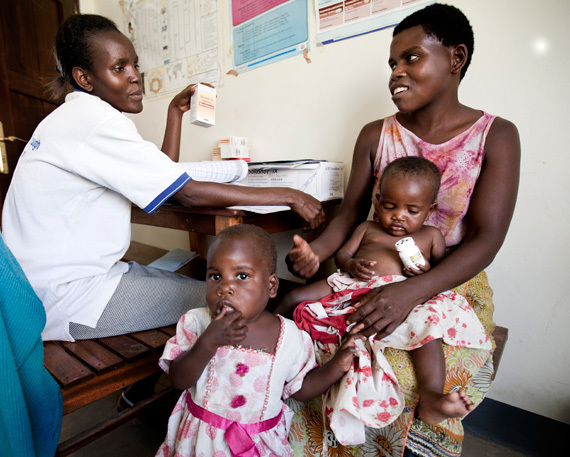2015 will be a landmark year for global health and development. Before the end of this year we will see the long awaited conclusion of the Millennium Development Goals (MDGs), as well as the finalization and adoption of the new Sustainable Development Goals (SDGs), which will drive efforts to improve the health and lives of people around the world through 2030 and beyond.
It is fitting that such an important year began with a record-breaking commitment to the health of the world's poorest children. In January, $7.5 billion was pledged by a host of donors to Gavi, the Vaccine Alliance. This unprecedented sum will fully fund the immunization efforts supported through Gavi from 2016 - 2020, and put implementing countries on track to immunize 300 million children in the next five years, preventing between 5 and 6 million premature deaths in the process.
The impact on the lives of these children and the wider public health benefits of this commitment are immense.
A Transformative Approach
Gavi has been a transformative model for public-private health partnerships since its inception in 2000--providing vaccinations for half a billion children around the world. It is deeply encouraging to see more than 17 sovereign nations and a multitude of private, corporate, and non-governmental partners coming together in support of such a crucial endeavor. The multilateral nature of Gavi's funding and implementation model has been the key to its great success.
Funding the Future Together
The principles of multilateral funding mechanisms are founded on the simple premise that the unified response of a global community will always be more effective than isolated efforts.
And nowhere is this principle clearer than in the effort to end the AIDS epidemic. Like Gavi's groundbreaking progress to end preventable childhood illness through vaccines, multilateral bodies such as the Global Fund to Fight AIDS, Tuberculosis and Malaria and UNITAID, coupled with bilateral support from programs like the U.S. President's Emergency Plan for AIDS Relief (PEPFAR), have changed the landscape of the AIDS epidemic in Africa--especially when it comes to ending AIDS in children.
Globally, since 2001, there has been a 58 percent reduction in new pediatric HIV infections. Such progress is largely due to multilateral and bilateral support provided to ministries of health, and the on-the-ground work of implementing partners like the Elizabeth Glaser Pediatric AIDS Foundation (EGPAF).
Just at the end of last year, UNITAID announced new commitments to dramatically expand access to care for children living with HIV. Through its unique multilateral funding model, UNITAID leveraged $63 million in funds that will enable a tenfold increase in treatment for children across nine countries.
Working through EGPAF and local ministries of health, these funds will be used to strengthen and expand the early diagnosis of children exposed to HIV in areas of concentrated need. This will result in more children put on treatment precisely at the time they are most vulnerable.
Gavi, the Global Fund, and UNITAID leverage the strengths of the disparate sectors of the global health community, public and private, to achieve maximum financial and programmatic effect. By combining multiple types of funding, from direct multi-year contributions from governments to private-public partnerships and innovative financial mechanisms, they create a diverse and robust pool of resources to draw from.
In doing so they also create an atmosphere of communal responsibility, where nations, companies and communities can work together with common purpose to address the universal challenges of health and development.
Perhaps the most important feature of these mechanisms is their recognition of recipient countries as the ultimate decision makers and owners of health interventions within their borders. Indeed, the success of public health efforts depends as much, if not more, on the abilities and actions of national health systems and the multitude of clinics, doctors, nurses, and other staff on the ground, as it does on the funds provided by Gavi or UNITAID.
By working in concert with national health systems, the long-term sustainability and prioritization of public health efforts is further strengthened. Evidence that countries are continuing to take the lead is apparent in the $1.2 billion Gavi implementing countries are projected to spend of their own money on national vaccine programs, independent of Gavi supported funds, from 2016 - 2020.
Similarly, the Global Fund is committed to emboldening country leadership and facilitating national action. Countries take the lead through every stage of funding, which is guided from the beginning by national strategies and priorities. Multilateral models recognize that countries are the only ones truly dealing directly with their health challenges and are in the best position to determine the day-to-day needs and realities on the ground, with external actors providing funding, resources, technical, and other guidance.
The Global Fund model, and others like it, relies on an open and continuous dialogue within and between countries, and partners across sectors. Its success depends on this effective communication and the development of partnerships between governments, civil society, corporate, and private actors.
Increased access to vaccines and HIV/AIDS treatment and prevention services, has been one of the most important public health successes in the modern age--greatly reducing the number of childhood deaths, especially for those children in the fragile under-five age range.
We've learned success in global health, and particularly in the field of HIV, relies on the principles of country leadership, collaboration, and cooperation. Only when policymakers, health ministries, and civil society work together can the suffering caused by poverty and disease truly be alleviated, especially for children. And there is still much work ahead.
6.3 million children under the age of five died in 2013 - a truly sobering figure.
If we are to reduce this number to zero and witness the birth of the first AIDS-free generation, our efforts must be united. For divided we will most certainly fall, where we can barely afford to stumble.

